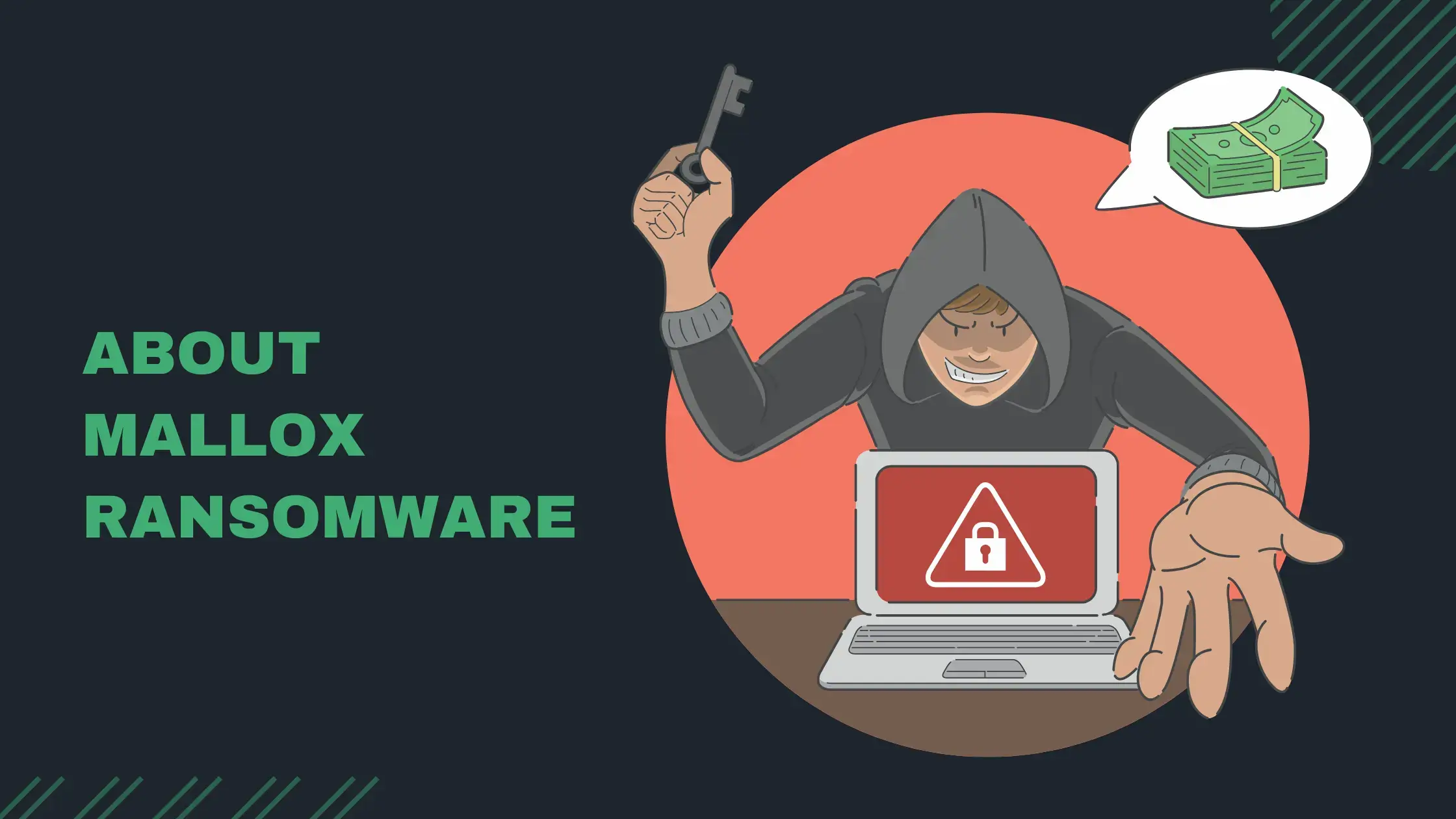Mallox Ransomware: What is it?
Meet Mallox ransomware, a notorious strain that goes by multiple aliases such as TargetCompany, FARGO, and Tohnichi. This malevolent malware is laser-focused on targeting Microsoft (MS) Windows systems, gaining access through vulnerable MS-SQL servers to infiltrate its victims’ networks.
Much like its counterparts in the ransomware world, Mallox follows the sinister trend of double extortion. Before encrypting an organization’s valuable files, the attackers stealthily steal sensitive data from their systems. Then, they use this pilfered information as leverage, coercing the victims to pay the ransom fee. The attackers brazenly threaten to expose the confidential data on a leaked site if their demands are not met. This high-pressure tactic is designed to force affected organizations into compliance.
The operators behind Mallox ransomware leave no stone unturned in their pursuit of malevolence. They employ various tactics, including brute forcing, data exfiltration, and strategic use of network scanners, all aimed at achieving their malicious objectives.
How Does Mallox Ransomware Target and Exploit?
Ever since it was founded in 2021, the Mallox group has remained steadfast in its approach to infiltrate target networks. Their signature modus operandi revolves around exploiting vulnerable MS-SQL servers as the key entry point. To achieve this, they employ a dictionary brute force attack, systematically trying out a list of known or commonly used passwords against the targeted MS-SQL servers. Once they manage to gain access, they take advantage of command line and PowerShell commands to download the Mallox ransomware payload from a remote server and skillfully deploy it within the compromised network.
Preventive Measures Against Mallox Ransomware
Keeping Microsoft SQL Server instances secure is absolutely vital in safeguarding against Mallox Ransomware attacks. To fortify your defense against potential threats, it is highly advisable to take the following recommended steps:
- Avoid Exposing SQL Servers on Default Ports: Since this port is widely known and frequently targeted by hackers, you must avoid this. Opt for a safer connection method, such as a Virtual Private Network (VPN), when accessing your SQL servers remotely. This will add an extra layer of security to protect your servers from potential threats.
- Disable or Secure the sa Account: The sa (system administrator) account holds the highest level of privileges in SQL Server, making it a prime target for potential security breaches. To bolster security, it is crucial to either disable this account altogether or, alternatively, change its password to a strong and unique one. Taking these measures significantly reduces the risk of unauthorized access to this critical account, thus enhancing the overall security of your SQL Server environment.
- Audit SQL CLR Assemblies: If you have SQL CLR assemblies that are not integral to your SQL Server operations, it’s wise to disable them. To ensure a secure environment, consider implementing a routine auditing process to review all existing CLR assemblies and remove any that are not essential. This proactive approach minimizes potential vulnerabilities and helps maintain the overall integrity of your SQL Server system.
- Utilize a Firewall: It’s essential to configure a firewall with specific access restrictions. Allow incoming traffic only from trusted networks and designated IP addresses while blocking all other access on port 1433. By doing so, you ensure that only authorized users have the necessary access to your SQL servers, significantly reducing the risk of unauthorized access and potential security breaches.
- Keep SQL Server Updated: Keep your SQL Server instance up to date by regularly installing the latest updates and patches. This ensures protection against known vulnerabilities and potential exploits.
- Implement Strong and Unique Passwords: Enforce the use of strong and unique passwords for all SQL logins. Combine upper and lower case letters, numbers, and special characters to enhance password complexity and make them harder to crack.
- Configure Account Lockout Policies: Implement account lockout policies to automatically lock out SQL Server logins after multiple failed attempts. This precautionary measure helps safeguard against brute force attacks.
- Encrypt Data in Transit with SSL/TLS: Utilize SSL/TLS to encrypt data during transit between clients and your SQL servers. This added layer of encryption protects against eavesdropping and other potential attacks on data in transit.
- Monitor SQL Server Activity: Leverage SQL Server auditing capabilities to monitor and log all activities on your SQL Server instance. This proactive approach assists in detecting and promptly responding to any potential security threats.
Incorporating these measures into your Microsoft SQL Server instances will greatly bolster their security and reduce the risk of falling victim to Mallox Ransomware attacks or other potential security breaches. By taking these proactive steps, you can rest assured that your data and systems are well-protected, providing you with peace of mind and a more secure operating environment.
Indicators of Compromise
Here is an example of command line used by Mallox Ransomware to stop and remove SQL-related services:
“C:\Windows\System32\cmd.exe” / C sc delete “MSSQLFDLauncher” && sc delete “MSSQLSERVER” && sc delete “SQLSERVERAGENT” && sc delete “SQLBrowser” && sc delete “SQLTELEMETRY” && sc delete “MsDtsServer130” && sc delete “SSISTELEMETRY130” && sc delete “SQLWriter” && sc delete “MSSQL$VEEAMSQL2012” && sc delete “SQLAgent$VEEAMSQL2012” && sc delete “MSSQL” && sc delete “SQLAgent” && sc delete “MSSQLServerADHelper100” && sc delete “MSSQLServerOLAPService” && sc delete “MsDtsServer100” && sc delete “ReportServer” && sc delete “SQLTELEMETRY$HL” && sc delete “TMBMServer” && sc delete “MSSQL$PROGID” && sc delete “MSSQL$WOLTERSKLUWER” && sc delete “SQLAgent$PROGID” && sc delete “SQLAgent$WOLTERSKLUWER” && sc delete “MSSQLFDLauncher$OPTIMA” && sc delete “MSSQL$OPTIMA” && sc delete “SQLAgent$OPTIMA” && sc delete “ReportServer$OPTIMA” && sc delete “msftesql$SQLEXPRESS” && sc delete “postgresql-x64-9.4” && rem Kill “SQL” && taskkill – f – im sqlbrowser.exe && taskkill – f – im sqlwriter.exe && taskkill – f – im sqlservr.exe && taskkill – f – im msmdsrv.exe && taskkill – f – im MsDtsSrvr.exe && taskkill – f – im sqlceip.exe && taskkill – f – im fdlauncher.exe && taskkill – f – im Ssms.exe && taskkill – f – im SQLAGENT.EXE && taskkill – f – im fdhost.exe && taskkill – f – im fdlauncher.exe && taskkill – f – im sqlservr.exe && taskkill – f – im ReportingServicesService.exe && taskkill – f – im msftesql.exe && taskkill – f – im pg_ctl.exe && taskkill – f – im postgres.exe
SHA256 hashes for Mallox Ransomware samples
- 6c743c890151d0719150246382b5e0158e8abc4a29dd4b2f049ce7d313b1a330
- b03f94c61528c9f3731a2e8da4975c072c9ed4e5372d3ec6b0939eebe01e54a4
- de9d3e17555e91072919dc700dc7e588cd52617debcad2f764ef9c7fbf6c9f7b
- 2a549489e2455a2d84295604e29c727dd20d65f5a874209840ce187c35d9a439
- 1c8b6d5b79d7d909b7ee22cccf8f71c1bd8182eedfb9960c94776620e4543d13
- 36269d1892283991a9db23492cd8efcd68af74060384b9686219a97f76a9989e
- 10eea0c13fd1a782c065627e23e7051edc1622f2eae5fbe138725369c12f4b6d
- Df30d74ab6600c1532a14c53a7f08f1afd41ec63cf427a4b91b99c3c2524caba
- 0463277782f9e98b0e7a028cea0f689a81cf080fa0d64d4de8ef4803bb1bf03a
- 1f793f973fd906f9736aa483c613b82d5d2d7b0e270c5c903704f9665d9e1185
- e284ad63a832123240bd40b6c09565fae8525c00ddf308d5b8f5c8ce69ed6b09
- e3a0bbd623db2b865fc3520c8d05e8b92016af2e535f0808460295cb8435836a
- 7c84eafb3b05f0d5316fae610d9404c54ef39383d0fe0e3c07407a26bb9f6750
- 1276786fc51f3b7e987aa95ebff0a3e1e358ee4e86e2302e472f84710271af7b
- f730e83049c7fe81f6e4765ab91efbb7a373751d51fdafe697a4977dc7c1ea11
- 05194b34f8ff89facdd7b56d05826b08edaec9c6e444bdc32913e02cab01afd4
- c599bebc9ae54a54710008042361293d71475e5fbe8f0cbaceb6ee4565a72015
- 060ed94db064924a90065a5f4efb50f938c52619ca003f096482353e444bd096
- 90be90ad4fb906574f9e7afe587f0826a71152bfc32cfc665a58877562f2edd4
- 1b2727af9fc187cd5c932c6defe50b983ad7508b4196ad6c5ff5e96686277c56
- a9543bc9612276863fc77b663fa3ff6efb85db69a01baa86c6dfabf73684b5c1
- 4e00f3e0e09d13e76da56009173098eefafc4ad50806583d5333990fa44e6420
- 6c109d098a1f44017f3937a71628d9dbd4d2ca8aa266656ee4720c37cc31558e
- 7f8f1afa1390246409263e606aa05e2896b8d1da7018c534e67ca530a59ebda1
- 8e54c38bc3585c3163c3e25d037bcf55695c274aaea770f2f59f0a0910a4b572
- 724aa6dae72829e9812b753d188190e16fb64ac6cd39520897d917cfdccc5122
- 7164ba41639c8edcd9ff1cf41a806c9a23de566b56a7f34a0205ba1f84575a48
- 0e1c7ea4148e7473e15a8e55413d6972eec6e24ef365e9f629884f89645de71a
- 4ed74a205fad15c843174d7d8b30ae60a181e79f31cc30ebc683072f187e4cdd
- ee6fd436bf5aff181e3d4b9a944bf644076e902a1bbf622978b5e005522c1f77
- ebdcf54719cceddffc3c254b0bfb1a2b2c8a136fa207293dbba8110f066d9c51
- 9a3050007e1c46e226e7c2c27d4703f63962803863290449193a0d0ca9661b3b
- d6c51935d0597b44f45f1b36d65d3b01b6401593f95cb4c2786034072ad89b63
- 586d4f86615cb3a8709ae1c08dde35087580814c1d1315af3d7b932639ff48e0
- 8e974a3be94b7748f7971f278160a74d738d5cab2c3088b1492cfbbd05e83e22
- 3fa36079fdc548db1b5122450c2e4c9e40c37059de116d1c03f6459b13fc2dc4
- D15f12a7cf2e8ec3d6fceabfab64956c7e727caab91cff9c664f92b5c8552570
- 0427a9f68d2385f7d5ba9e9c8e5c7f1b6e829868ef0a8bc89b2f6dae2f2020c4
- 4cbac922af3cfaba5fa7a3251bd05337bffd9ed0ada77c55bb4f78a041f4ebf2
- 10f96f64659415e46c3f2f823bdb855aab42d0bfced811c9a3b72aea5f22d880
- 5ccff9af23c18998221f45396732539d18e330454327d1e7450095c682d8c552
- 77fdce66e7f909300e4493cbe7055254f7992ba65f9b7445a6755d0dbd9f80a5
- ee08e3366c04574f25909494ef276e65e98d54f226c0f8e51922247ca3cfade9
- 2fd3c8fab2cfaaabf53d6c50e515dd5d1ef6eceeebdd5509c23030c4d54cb014
- 603846d113ef1f588d9a3a695917191791fbad441f742bcfe797813f9fc5291e
- a5085e571857ec54cf9625050dfc29a195dad4d52bea9b69d3f22e33ed636525
- 9b833d5b4bdbc516e4773c489ced531b13028094ce610e96ebc30d3335458a97
- b9e895830878124e20293f477549329d4d8752ff118f4fe893d81b3a30852c0b
- cd80506f971b95b3b831cef91bb2ec422b1a27301f26d5deac8e19f163f0839a
- c0e35b19f97021416e3724006511afc95d6aa409404e812d8c62b955bc917d3c
- 342930d44aed72f826a3f0f4a3964158f2bd86fb53703fb3daa6c937b28a53e4
- 9ee35c6eb97230cd9b61ba32dba7befea4122f89b3747d2389970050a1d019f9
- e7e00e0f817fcb305f82aec2e60045fcdb1b334b2621c09133b6b81284002009
- e3f63ab8ef91e0c52384c0e3e350db2427c8cb9237355800a3443b341cf8cf4f
- f7e8a0eac54dd040e2609546fca263f2c2753802ff57e7c62d5e9ccfa04bdb1a
- e7178a4bad4407316b85894307df32fdf85b597455364eb8ec4d407749e852ce
SHA256 hashes for PowerShell scripts Updt.ps1 and Upddt.ps1
- dcc9e23fd6ac926eb9ee7e0ee422dacd2059b4a42c8642d32bdf4f5c8eb33f6a
- fead3d518752ddb4d2407f16ca5f3c9b3c0bf01972a2618369d02913f7c6af1a
- 0901a9920c9f0c74fb2170524477693d62c8493715520ae95143abd8055e7a39
- ba97fd533e8a552664695434227b24ca1e2e661c360a7a0a40ff59ba6b8fe949
- 53da732df7599f5ad21a26b669500788a827f3a8358dcdca10997d2b8187c95c
- 189c9c4603defb14fa8c942f5ff7814804654269917640478686530f91c4b66c
- fd0030883b9e74b383ee6381a2aaa7e2e5b93a00003b555e2f7c8b7be65ab176
- d22b3218c4b7f13fe114854d1dbda02c3ad94a1b6c69daa1cf6a504ada8b8bca
- b6447b0636085fcb41fd574e84500958f21dfe87fe06b0813fb9399d63f28851
- 5c34f6fa6eada3197404bf95eced9d288688537598629158a4f4e18d6882cb9b
- d81b0425d4ec49bad194b8dc750524c2a29994fe972e733376349f47961cfa62
System.bat
1e2515efb64200258752d785863fd35df6039441a80cb615dfff4fbdffb484ec
777a5782426e5b42e0e5e8445dd9602d123e8acc27aca4daa8e9c053f3d5b899
9e3684be0b4c2dc93f962c03275e050fed57d9be6411396f51bdf8d4bb5e21c0
cb47327c7cce30cff8962c48fa3b51e57e331e1592ea78b21589164c5396ccd9
Mallox Ransomware-associated IP addresses
- 103.96.72[.]140
- 80.66.75[.]36
- 80.66.75[.]37
- 80.66.75[.]126
- 80.66.75[.]116
- 92.118.148[.]227
- 62.122.184[.]113
- 87.251.64[.]245
- 119.3.125[.]197
- 49.235.255[.]219
- 80.66.75[.]55
- 87.251.67[.]92
- 121.4.69[.]26
- 124.223.11[.]169
- 45.93.201[.]74
- 80.66.75[.]135
- 194.26.135[.]44
- 80.66.75[.]51
- 89.117.55[.]149
- 5.181.86[.]241
- 185.170.144[.]153
Summary
Understanding the complexities of Mallox Ransomware is critical for protecting our digital ecosystem. This destructive strain of ransomware employs sophisticated strategies like double extortion to attack weaknesses in Microsoft SQL Server systems. We can strengthen our defences against Mallox and similar threats by adopting important security practices such as updating software, using strong passwords, imposing firewall limitations, and enabling encryption.
If you are looking for servers that are safe from such threats, you must visit:- Lease Packet We have fully managed servers that are optimized by experts and come with 24×7 server support. Our experts make sure all such threats stay away from your servers.

























